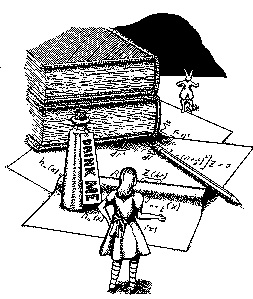CRN 12107: HW 2
HelmutKnaust (Talk | contribs) (Created page with "'''Problem 6.''' Is the statement $\quad\exists !\,x\in\mathbb{R} : (x-2=\sqrt{x+7}) \quad$ true or false? Prove your conjecture. '''Problem 7.''' Let $A,B$ and $C$ be arbitr...") |
HelmutKnaust (Talk | contribs) |
||
| (One intermediate revision by one user not shown) | |||
| Line 8: | Line 8: | ||
#$(A \bigtriangleup B)\bigtriangleup C=A \bigtriangleup (B \bigtriangleup C)$. | #$(A \bigtriangleup B)\bigtriangleup C=A \bigtriangleup (B \bigtriangleup C)$. | ||
| − | '''Problem 8.''' Let $A$ and $B$ be arbitrary sets. Prove or disprove: | + | '''Problem 8.''' Let $A$ and $B$ be arbitrary sets. Prove or disprove the following power set relations: |
#${\cal P}(A\cap B)\subseteq {\cal P}(A)\cap {\cal P}(B)$. | #${\cal P}(A\cap B)\subseteq {\cal P}(A)\cap {\cal P}(B)$. | ||
#${\cal P}(A)\cap {\cal P}(B)\subseteq {\cal P}(A\cap B)$. | #${\cal P}(A)\cap {\cal P}(B)\subseteq {\cal P}(A\cap B)$. | ||
| Line 14: | Line 14: | ||
'''Problem 9.''' Given two real numbers $a<b$, the open interval $(a,b)$ is defined to be the set $\displaystyle{\{x\in\mathbb{R}\ |\ (a<x) \wedge (x<b)\}}$. | '''Problem 9.''' Given two real numbers $a<b$, the open interval $(a,b)$ is defined to be the set $\displaystyle{\{x\in\mathbb{R}\ |\ (a<x) \wedge (x<b)\}}$. | ||
| − | For $n\in\mathbb{N}$, let $A_n$ be the open interval $\displaystyle{(\frac{1}{2}-\frac{1}{ | + | For $n\in\mathbb{N}$, let $A_n$ be the open interval $\displaystyle{(\frac{1}{2}-\frac{1}{2n}, \frac{1}{2}+\frac{1}{3n})}$. Find $\displaystyle{\bigcup_{n\in\mathbb{N}} A_n}$ and $\displaystyle{\bigcap_{n\in\mathbb{N}} A_n}$. Confirm your conjectures by proofs. |
'''Problem 10.''' Critique the following proof. Is the proof correct or flawed? Explain! | '''Problem 10.''' Critique the following proof. Is the proof correct or flawed? Explain! | ||
| − | Recall that a positive integer $p$ is ''prime'' if it is divisible by exactly two positive integers, namely $1$ and $p$. | + | Recall that a positive integer $p$ is ''prime'' if it is divisible by exactly two positive integers, namely $1$ and $p$. The five smallest primes are 2,3,5,7,11. |
'''Theorem.''' There are infinitely many primes. | '''Theorem.''' There are infinitely many primes. | ||
| Line 25: | Line 25: | ||
'''Proof:''' Suppose there are only finitely many primes, say the list of all primes is $\{p_1,p_2,p_3,\ldots, p_n\}$ for some positive integer $n$. Set | '''Proof:''' Suppose there are only finitely many primes, say the list of all primes is $\{p_1,p_2,p_3,\ldots, p_n\}$ for some positive integer $n$. Set | ||
\[p=1+p_1\cdot p_2 \cdot p_3 \cdots p_n.\] | \[p=1+p_1\cdot p_2 \cdot p_3 \cdots p_n.\] | ||
| − | Then $p$ leaves a remainder of 1 when divided by any of the $p_n$'s and thus must be a prime not on the list of all primes. | + | Then $p$ leaves a remainder of 1 when divided by any of the $p_n$'s and thus $p$ must be a prime not on the list of all primes. |
| + | |||
| + | [[Image:Alice3.gif]] | ||
Latest revision as of 22:28, 10 September 2013
Problem 6. Is the statement $\quad\exists !\,x\in\mathbb{R} : (x-2=\sqrt{x+7}) \quad$ true or false? Prove your conjecture.
Problem 7. Let $A,B$ and $C$ be arbitrary sets. Recall that $A\setminus B=\{x \ |\ x\in A\ \wedge\ x\not\in B\}$. We define $A\bigtriangleup B:=(A\setminus B)\cup(B \setminus A)$. Prove or disprove:
- $A \bigtriangleup B= B \bigtriangleup A$.
- $(A \bigtriangleup B)\bigtriangleup C=A \bigtriangleup (B \bigtriangleup C)$.
Problem 8. Let $A$ and $B$ be arbitrary sets. Prove or disprove the following power set relations:
- ${\cal P}(A\cap B)\subseteq {\cal P}(A)\cap {\cal P}(B)$.
- ${\cal P}(A)\cap {\cal P}(B)\subseteq {\cal P}(A\cap B)$.
Problem 9. Given two real numbers $a<b$, the open interval $(a,b)$ is defined to be the set $\displaystyle{\{x\in\mathbb{R}\ |\ (a<x) \wedge (x<b)\}}$.
For $n\in\mathbb{N}$, let $A_n$ be the open interval $\displaystyle{(\frac{1}{2}-\frac{1}{2n}, \frac{1}{2}+\frac{1}{3n})}$. Find $\displaystyle{\bigcup_{n\in\mathbb{N}} A_n}$ and $\displaystyle{\bigcap_{n\in\mathbb{N}} A_n}$. Confirm your conjectures by proofs.
Problem 10. Critique the following proof. Is the proof correct or flawed? Explain!
Recall that a positive integer $p$ is prime if it is divisible by exactly two positive integers, namely $1$ and $p$. The five smallest primes are 2,3,5,7,11.
Theorem. There are infinitely many primes.
Proof: Suppose there are only finitely many primes, say the list of all primes is $\{p_1,p_2,p_3,\ldots, p_n\}$ for some positive integer $n$. Set \[p=1+p_1\cdot p_2 \cdot p_3 \cdots p_n.\] Then $p$ leaves a remainder of 1 when divided by any of the $p_n$'s and thus $p$ must be a prime not on the list of all primes.
